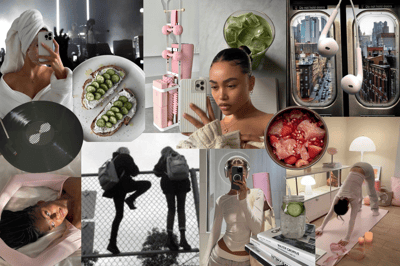From Pinterest to Pressure: The Dark Side of Aesthetic Culture
Discover how the obsession with curating a perfect aesthetic is impacting Gen Z’s mental health and authenticity. From Pinterest boards to Instagram feeds, explore the hidden pressure behind the picture-perfect life.
MENTAL WELLNESSLIFESTYLE
Deepita
4/19/20254 min read


We’ve all been there—endlessly scrolling through Pinterest boards, Instagram reels, or TikTok routines, soaking in the perfectly arranged bedrooms, matcha mornings, and aesthetic outfits that feel straight out of a dream. It’s calming, inspiring… and oddly exhausting.
In today’s digital world, aesthetics aren’t just about art or fashion anymore—they’ve become a lifestyle standard, a measuring stick for how put-together, productive, and "with it" you appear. For Gen Z especially, curating a visually pleasing life isn’t just a creative outlet—it’s become a quiet expectation.
But beneath the soft filters and symmetrical flat lays lies a growing tension: Are we living for ourselves, or just performing for the feed? This blog dives into the darker side of aesthetic culture—the pressure to curate, the fear of imperfection, and the quiet burnout of always trying to be "on brand."
The Rise of Aesthetic Culture: When Style Becomes a Standard
Aesthetics used to be about personal taste—the unique way you styled your room, dressed for the day, or chose your playlist. But somewhere between Pinterest boards and TikTok algorithms, style stopped being just a choice and quietly became a standard.
What began as creative inspiration—like cottagecore, dark academia, or the clean girl look—morphed into entire lifestyles. These aesthetics aren’t just about how things look; they’re about how you live, what you eat, what you wear, and even how you speak. And suddenly, everything from your morning coffee to your digital calendar had to be aesthetic-approved.
Social media amplified this shift. Platforms like Instagram encouraged perfectly curated grids, while TikTok fed us endless “day in the life” videos with calming music and color-matched outfits. Slowly, our feeds became a mirror—and if our lives didn’t match up to the visuals we saw, we felt like something was off.
It’s not just content anymore. It’s a performance.
Instead of sharing moments, we’re styling them. And while there’s nothing wrong with wanting your space or life to look beautiful, the pressure to always live within a specific aesthetic can make the authentic feel inadequate. When your personality starts bending to match a trending vibe, you have to ask—is it still you behind the filter?
The Silent Toll: Aesthetic Pressure and Mental Health
While aesthetic culture may look calming on the outside—muted tones, cozy corners, and perfect lighting—it often hides a quiet chaos underneath. For many Gen Zers, the pressure to maintain an aesthetic life is less about creativity and more about conformity. And that takes a mental toll.
Constantly comparing your real, unfiltered life to someone else’s curated version can lead to:
Low self-esteem: Feeling like you’re never “on trend” enough.
Imposter syndrome: Living a life that looks good online but feels disconnected offline.
Anxiety and burnout: Trying to keep up with an aesthetic that demands perfection in every detail.
The worst part? It’s subtle. You don’t always notice when this pressure creeps in. One day you’re arranging your desk for fun, and the next you’re stressing about whether your coffee cup “fits your vibe.”
Aesthetic culture can also cause a disconnect between how we present ourselves and how we actually feel. We might be going through rough days, burnout, or personal struggles—but still feel the need to post a perfect picture, because chaos doesn’t match the grid.
This curated perfection creates a false sense of normal, making authenticity feel like a risk instead of a relief.
Embracing the Anti-Aesthetic Movement
Thankfully, Gen Z isn’t just living through aesthetic pressure—we’re also the ones pushing back. A new wave of digital authenticity is rising, and it's reshaping how we show up online. Movements like:
BeReal – Capturing the moment without filters or second takes.
Photo dumps – Sharing the raw, chaotic, and real instead of just the polished.
Deinfluencing – Calling out unnecessary consumerism and encouraging mindful choices.
Unedited vlogs and “low-effort” content – Letting imperfection be part of the narrative.
These trends prove one thing: real life is making a comeback. We’re done with the pressure to always “look the part.” Now, we’re more interested in feeling it—being present, genuine, and honest about our experiences.
You don’t have to ditch your aesthetic to be real. You just have to stop letting it define your worth.
How to Avoid Aesthetic Overload
If you’re feeling overwhelmed by the need to constantly curate your life, here are five small but powerful shifts you can make:
Post without pressure – Every moment doesn’t have to fit your grid. Share what feels real, not just what looks right.
Be okay with the ‘ugly’ parts – Life isn’t always camera-ready. And that’s what makes it beautiful.
Create before you curate – Express yourself freely before worrying about how it looks to others.
Follow real people – Choose creators who share authentically, not just highlight reels and brand deals.
Do it for you – Whether it’s journaling, dressing up, or redecorating your space—make sure it's something you enjoy, not what’s trending.




